Paulina found elsewhere in Cuba ancient descriptions and symbols that was identical to those on the waterfront structures below.
The two scientists used submarines to found tremendous pyramid structures (that reminds one of Giza in Egypt), built of stones weighing hundreds of tons.

They found sphinxes, stones that arranged like Stonehenge, and a written language engraved on the stones.
Why it was not discovered before?
The U.S. government discovered the alleged place during the Cuban missile crisis in the sixties, Nuclear submarines cruising in the Gulf (in deep sea) met pyramid structures. They immediately shut down the site and took control of him and the objects,in order that it will not come to Russians hands.
A whistleblower from the army,that used to serve in Montego Bay said they are still working on the site and recover objects and instruments (including those who still work) since the 60′s.
This area in Cuba was above water 10,000 years ago…
The Morien Institute interviews Dr. Weinzweig and you can read this HERE
Additional links:
http://www.youtube.com/watch?v=klRbcEnLPbU
http://www.youtube.com/watch?v=hk6SWtumdK0&feature=related
source: http://www.utaot.com/2012/09/24/pyramid-structures-near-western-cuba/
Kirvi is a mountain in Suðuroy, near the village Lopra. Kirvi is 236 meter high. The mountain is visible from the villages Lopra and from Nes, which is between Vágur and Porkeri. The mountain is located in the municipality of Sumba.
The two scientists used submarines to found tremendous pyramid structures (that reminds one of Giza in Egypt), built of stones weighing hundreds of tons.

They found sphinxes, stones that arranged like Stonehenge, and a written language engraved on the stones.
Why it was not discovered before?
The U.S. government discovered the alleged place during the Cuban missile crisis in the sixties, Nuclear submarines cruising in the Gulf (in deep sea) met pyramid structures. They immediately shut down the site and took control of him and the objects,in order that it will not come to Russians hands.
A whistleblower from the army,that used to serve in Montego Bay said they are still working on the site and recover objects and instruments (including those who still work) since the 60′s.
This area in Cuba was above water 10,000 years ago…
The Morien Institute interviews Dr. Weinzweig and you can read this HERE
Additional links:
http://www.youtube.com/watch?v=klRbcEnLPbU
http://www.youtube.com/watch?v=hk6SWtumdK0&feature=related
source: http://www.utaot.com/2012/09/24/pyramid-structures-near-western-cuba/
The Pyramids of Faroe Islands
The pyramid shaped mountain is called Kirvi and the top of it is called Kirviskollur. You can also see the to top of Beinisvørð to the left in the photo. Beinisvørð is a 469 m high birdcliff. It is absolutely worth a visit.Kirvi is a mountain in Suðuroy, near the village Lopra. Kirvi is 236 meter high. The mountain is visible from the villages Lopra and from Nes, which is between Vágur and Porkeri. The mountain is located in the municipality of Sumba.
source: http://www.utaot.com/2012/09/21/the-pyramids-in-faroe-islands/
Indonesia
The Gunung Padang Pyramid

Slowly but surely the mystery of the “pyramid” in Gunung Padang, Cianjur, West Java, is beginning to unravel. One by one, researchers claim to have found evidence that the pyramid-shaped mountain is man-made, and not a natural formation.
Radar imaging shows that the mountain hides enclaves of rock that
resemble shrines. If this hypothesis is correct, then the building that
has been forgotten for decades will allegedly defeat the discovery of
the pyramids in Egypt.
Tempo Magazine in its edition dated August 27, 2012, tracked the mystery of the Gunung Padang site. The age of the “pyramid” is estimated at 4,700-10,900 BC. Compare this to the age of the Giza pyramids in Egypt, which is only 2,500 BC old. But the research is limited still. That is why geologists continue to be skeptical about the “pyramid” is. Too early to be announced.
Gunung Padang became the talk of the town the Ancient Catastrophic Team conducted a study on Cimandiri quake fault, about four miles to the north of the site. The team was formed by Special Staff of the President to the Social and Natural Disasters Assistance Andi Arief.
The controversy erupted after Andi announced early last year that there was some kind of a pyramid under Gunung Padang. “Whatever the name or shape, it’s clear there hollows thereunder,” said Andi. “At a glance, it doesn’t look like a mountain, more manmade.”
His suspicion started because the shape of the mountain was nearly like a triangle when viewed from the north. The team earlier also found a similar form on Gunung Sadahurip in Garut and on Bukit Dago Pakar in Bandung expert while researching the Lembang fault.
Andi Arief says the work of his team at Gunung Padang is almost finished. When it comes to excavation, however, he gave up because it will cost a huge amount. “That is Arkenas’ job,” he said.
http://www.tempointeractive.com/hg/nasional/2012/08/28/brk,20120828…
Posted by tatooke on September 12, 2012

Tempo Magazine in its edition dated August 27, 2012, tracked the mystery of the Gunung Padang site. The age of the “pyramid” is estimated at 4,700-10,900 BC. Compare this to the age of the Giza pyramids in Egypt, which is only 2,500 BC old. But the research is limited still. That is why geologists continue to be skeptical about the “pyramid” is. Too early to be announced.
Gunung Padang became the talk of the town the Ancient Catastrophic Team conducted a study on Cimandiri quake fault, about four miles to the north of the site. The team was formed by Special Staff of the President to the Social and Natural Disasters Assistance Andi Arief.
The controversy erupted after Andi announced early last year that there was some kind of a pyramid under Gunung Padang. “Whatever the name or shape, it’s clear there hollows thereunder,” said Andi. “At a glance, it doesn’t look like a mountain, more manmade.”
His suspicion started because the shape of the mountain was nearly like a triangle when viewed from the north. The team earlier also found a similar form on Gunung Sadahurip in Garut and on Bukit Dago Pakar in Bandung expert while researching the Lembang fault.
Andi Arief says the work of his team at Gunung Padang is almost finished. When it comes to excavation, however, he gave up because it will cost a huge amount. “That is Arkenas’ job,” he said.
http://www.tempointeractive.com/hg/nasional/2012/08/28/brk,20120828…
Posted by tatooke on September 12, 2012

By GLR ANdReA - Posted on 12 September 2012
http://soundofheart.org/galacticfreepress/content/gunung-padang-pyramid-mystery
Java, Indonesia
Candi Sukuh
  |
  |
China
Xian was for a long time the capital of Ancient China. It has become a popular tourist destination for Westerners since the discovery of the “Terracotta Warriors”. The evidence of local pyramids is scant, due to the Chinese Government and its ‘forbidden zones’ surrounding the city of Xian in the Shensi Province. These zones are off-limits to foreigners, probably due to military and/or space program bases in the area. Within these zones there are possibly 100 pyramids, and some adventurers have managed to photograph a few them: |
 |
 |
 |
These are not stone pyramids, nor earth mounds, but a combination of the two – made of earth and clay, shaped like pyramids with flattened tops (the same technique as Teotiuhuacan). It is rumoured that in recent times the Chinese Government ordered the planting of trees on the pyramids as a way of disguising them as regular hills, or at least their making their shape harder to discern. New Zealand author Bruce Cathie sought information on their exact locations, so he could fit them into his Harmonic Grid. After initially denying their existence outright, the Chinese officials eventually conceded that there are some “trapezoidal tombs” [i] .
According to Hartwig Hausdorf [ii] , they differ in size from between 25 to 100 metres in height, with the exception of one, the Great White Pyramid. It is situated to the north, in the valley of Qin Lin, and is possibly the world’s largest pyramid, with an approximate height of 300 metres (twice the size of Egypt’s largest).
Update! - In 2004 Chris Maier studied satellite images of the Xian region, found the same pyramids as Hausdorf, and then went there and took a look. Turns out that they are not in a “forbidden zone”, are quite well known, and any tourist can take a look, or even climb the biggest pyramid for free! Read his article
Update! - In 2002-2007, Emperor Qin Shihuang’s tomb (home of the terracotta warriors) was proven (using radar and other remote sensing technologies) to be more than a earth mound – underneath the dirt is a four-sided, nine-stepped pyramid, very similar to those in Central America. Read more at Channel 4, and China.org - the image below is the shape they believe the pyramid takes.
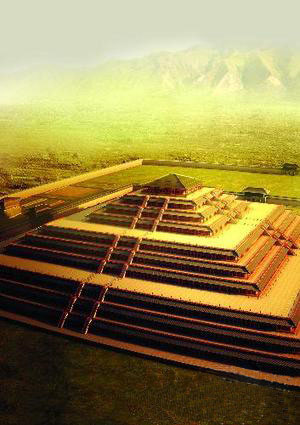
Russia – Brat & Sestra, nr Nakhodka
320 metres high each, they were until recently in a military zone. Today they are being mined (or could that be a cover for treasure hunting?) – which explains why the top has been removed from one of them. More at Flip Coppins site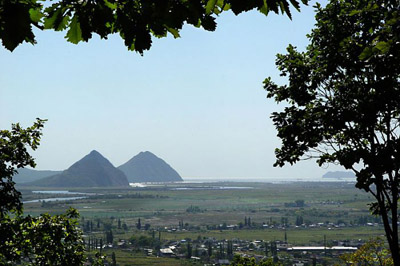
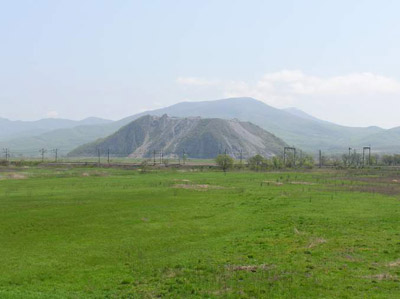
Korea
Andong step pyramid, is the best one of pyramids survived being undestroyed in South Korea, is located at soktapri, andong, korea, in the northern valley of Mt. Hakka, 30 km road away from Andong. 13.2 meters by 12.7 meters square and about 4.5 meters high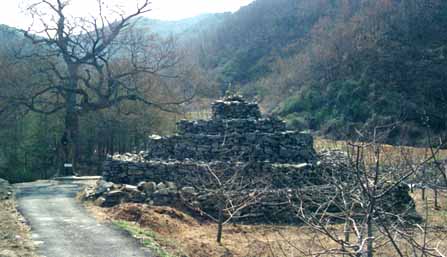
Tahiti
When Captain Cook visited Tahiti, he described the Marae of Mahaiatea as having a stepped pyramid with a base of 259 by 85 feet. Unfortunately all that remains today is a pile of stones. This drawing comes from the 1799 book The Voyage of McDuff.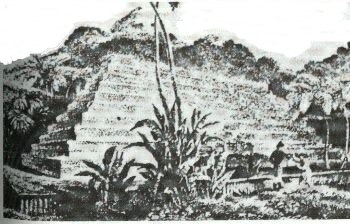 |
Western Samoa
On the island of Savai’i you can find Polynesia’s largest ancient structure, the Pulemelei Mound. The Lonely Planet guide for Samoa describes it:This large pyramid measures 61 metres by 50 metres at the base and rises in two tiers to a height of more than 12 metres. It is almost squarely oriented with the compass directions.. Smaller mounds and platforms are found in four directions away from the main structure. There is a relatively large platform about 40 metres north of the main pyramid and connected to it by a stone walkway.Unfortunately the jungle there is almost uncontrollable. The pyramid has been cleared on several occasions, but when I studied it in 1996 it was overgrown and difficult to locate. So much so, that it was only when I kicked a stone embedded in the top platform did I realise I had found it! The bottom right corner of the photo is the pyramid. UPDATE: Since 2002 the site has been cleared and studied by experts. New pictures and information.
Bosnian Pyramids
 In
the spring of 2006 five pyramids had been found in central Bosnia in
the town Visoko. The biggest is the Pyramid of the Sun with height of
220 metres. Other pyramids are also huge. The Bosnian pyramids don’t
look like the Egyptian pyramids. Scientists and researchers from Egypt,
Austria, England, Russia, Croatia and other countries join to
Archaeological Park: Bosnian Pyramids of the Sun Foundation to find the
truth about builders and meanings of the mysterious pyramids in Bosnia
and Herzegovina… >>>
In
the spring of 2006 five pyramids had been found in central Bosnia in
the town Visoko. The biggest is the Pyramid of the Sun with height of
220 metres. Other pyramids are also huge. The Bosnian pyramids don’t
look like the Egyptian pyramids. Scientists and researchers from Egypt,
Austria, England, Russia, Croatia and other countries join to
Archaeological Park: Bosnian Pyramids of the Sun Foundation to find the
truth about builders and meanings of the mysterious pyramids in Bosnia
and Herzegovina… >>>
The list of articles about the Bosnian Pyramids:Impressions of the Bosnia Pyramids—From One American’s Point of View By Sharon Prince Wothke
Official website: http://www.bosnianpyramidofthesun.com
Italy
Montevecchia
 located
about 40 km northeast of Milan and about 15 km south of Lecco in
Lombardy/Italy there is a small village with 3 pyramid shaped hills.
These hills in Montevecchia were discovered in 2003 by the Italian
architect Vincenzo DeGregorio.
located
about 40 km northeast of Milan and about 15 km south of Lecco in
Lombardy/Italy there is a small village with 3 pyramid shaped hills.
These hills in Montevecchia were discovered in 2003 by the Italian
architect Vincenzo DeGregorio.Read more on European Pyramids
Three pyramidal hills near Florence

14 km south of Florence/Tuscany there are 3 hills near the city of PONTASSIEVE (meaning: bridge over the river Sieve). These hills rise approx.140 m high from elevation 130 m to 270 m. The orientation is N-S/E-W with their edges. They stand in the so-called Orion formation, which means the geometrical pattern is equal to the Belt Stars of Orion. No excavation has been conducted so far. But the area of Pontassieve is well known for its prehistoric finds. There has been a paleolithic settlement dated to 25000 BC.
Read more on European Pyramids
Greece
 In
Greece, there are now 16 catalogued pyramids. Though some may be
natural, others—like the Hellinikon pyramid near the village of
Argolis—are clearly man-made structures. Intriguingly, one
thermo-luminescence test by the Academy of Athens has dated the
structure to 2720 BC, contemporaneous with the Egyptian pyramid age.
Though pyramidal in shape, the Greek structures do not enthral like the
Egyptian pyramids, which dwarf them in size. Read more on European Pyramids
In
Greece, there are now 16 catalogued pyramids. Though some may be
natural, others—like the Hellinikon pyramid near the village of
Argolis—are clearly man-made structures. Intriguingly, one
thermo-luminescence test by the Academy of Athens has dated the
structure to 2720 BC, contemporaneous with the Egyptian pyramid age.
Though pyramidal in shape, the Greek structures do not enthral like the
Egyptian pyramids, which dwarf them in size. Read more on European PyramidsPyramids of Tenerife island

There is a huge lava stone complex with 6 pyramids, partially reconstructed, in the town of Güimar on Tenerife. Discovered by Thor Heyerdahl in 1999 and turned into a museum with archaeological park.
Read more on European Pyramids
Slovenia
 In
Maribor, northern Slovenia close to the Austrian border, a hill named
Piramida (elevation 386m, height from base to top appr.80m) overlooks
the city and has once served as lookout post for the defence of the
city. Two more hills, called Kalvarija and Mesti Vrh, of similar height
and aligned with Piramida stand next to it. Read more on European Pyramids
In
Maribor, northern Slovenia close to the Austrian border, a hill named
Piramida (elevation 386m, height from base to top appr.80m) overlooks
the city and has once served as lookout post for the defence of the
city. Two more hills, called Kalvarija and Mesti Vrh, of similar height
and aligned with Piramida stand next to it. Read more on European PyramidsSource: http://www.world-pyramids.com/world.html
Notes on China

Pyramids and pyramidal structures are a worldwide phenomena, found in Egypt, Peru, Central America, America’s Mississippi Valley, France, Polynesia. Now we can add two more locations, China and Japan.For decades, one of the few clues that China has pyramids was a grainy, black and white photo of a huge, shadowy, pyramidal form. It is an aerial shot, taken by WWII USAF pilot James Gaussman, as he flew over China delivering supplies from India to Chungking, in the spring of 1945. (See article below)
 Today,
thanks to German researcher and author Hartwig Hausdorf, we have many
more photos, plus videotape and his eyewitness report of at least a
hundred pyramids in China’s Shensi Province. An e-mail message hooked me
up with Hausdorf. By telephone and fax, we’ve been corresponding, and
he was kind enough to send me two of his books in German. (Will someone
please publish his books in English so I can read them?) My friend Jo
Curran, fluent in German, read me selected portions of Satellites of the
Gods for this article. Hausdorf’s other book is entitled The White
Pyramid. Hausdorf will be a guest on The Laura Lee Show, the Saturday
Night radio show I host, on August 2nd. Here’s what I can say thus far.
Today,
thanks to German researcher and author Hartwig Hausdorf, we have many
more photos, plus videotape and his eyewitness report of at least a
hundred pyramids in China’s Shensi Province. An e-mail message hooked me
up with Hausdorf. By telephone and fax, we’ve been corresponding, and
he was kind enough to send me two of his books in German. (Will someone
please publish his books in English so I can read them?) My friend Jo
Curran, fluent in German, read me selected portions of Satellites of the
Gods for this article. Hausdorf’s other book is entitled The White
Pyramid. Hausdorf will be a guest on The Laura Lee Show, the Saturday
Night radio show I host, on August 2nd. Here’s what I can say thus far.Hausdorf came by his invitation to Xian, China, and the Chinese pyramids, when he attended a lecture by Erich von Daniken. A personal friend who wrote the foreword to one of his books, von Daniken was the first to bring the ancient astronaut theory to worldwide prominence through a series of popular books. It was at this lecture that he met Chen Jianli. They talked about Hausdorf’s research dealing with mysterious artifacts in China, including pyramids. Mr. Chen was born in Xian, and so, despite the official party line, did not consider pyramids in China to be nonsense; as a young boy, he had heard people talk of them. Through his connections in the Chinese capitol, Mr. Chen obtained a special permit for Hausdorf to travel in Xian’s forbidden zones. Not once, but twice; in March and October of 1994.
 The
Chinese don’t like to talk about their pyramids. Hausdorf couldn’t help
but notice that, in talking with high ranking archeologists at the
Beijing Academy of Sciences about these pyramids, the reaction was one
of panic. Only when shown the Gaussman photo would they reluctantly
confirm the existence of just a few pyramidal structures, near Xian.
That’s where Hausdorf found, not a few pyramids, but ninety to one
hundred such structures. There are signs that that attitude is changing.
The October 1996 issue of China Today, an official periodical issued in
Chinese, German, English, Arabic and French, contains an article about
Hausdorf’s second expedition through the Shensi pyramids.
The
Chinese don’t like to talk about their pyramids. Hausdorf couldn’t help
but notice that, in talking with high ranking archeologists at the
Beijing Academy of Sciences about these pyramids, the reaction was one
of panic. Only when shown the Gaussman photo would they reluctantly
confirm the existence of just a few pyramidal structures, near Xian.
That’s where Hausdorf found, not a few pyramids, but ninety to one
hundred such structures. There are signs that that attitude is changing.
The October 1996 issue of China Today, an official periodical issued in
Chinese, German, English, Arabic and French, contains an article about
Hausdorf’s second expedition through the Shensi pyramids.It was there that Hausdorf found pyramids either made of, or covered with, clay that has become nearly stone-hard over the centuries. They are undecorated, and partly damaged by erosion and farming. A few have carved stones standing in front of them. What of stone pyramids? That is found in Shandong. It has no steps. It is 50 feet tall, with a small temple at its apex, designed along the golden proportion.
How old are these pyramids? Prof. Wang Shiping of Xian estimates they are 4,500 years old. Hausdorf believes they are older, and tells of the diaries of two Australian traders. They were there in 1910 or 1912 and came across some of the pyramids, writes Hausdorf. When asking an old Buddhist monk, they were told, that the pyramids are not just mentioned in the 5,000-year-old records of his monastery, but said to be very old. That means, they are at least more than 5,000 years old!
In investigating what the Chinese authorities will reveal about the pyramids, Hausdorf was told the story of an emperor, Qin Shi Huangdi, who lived between 259 and 210 B.C. Prior to his reign, bitter feuding between rival states for dominance over a splintered China went on from 475 to 221 B.C. It was Emperor Huangdi who ended the fighting. And thanks to the commentaries of historian Sima Qian, who lived from 145 to 86 B.C., we know the existence and location of the emperor’s grave, beneath a hill 150 feet tall, planted with grass and trees. The hill, apparently, is man-made. According to Sima, beneath this hill is a 140-foot-tall pyramid with five terraces. The historian’s chronicles state that almost 700,000 workers worked on this tomb. The earth was removed down to ground water level. The floor was then poured with molten bronze. On this platform a stone sarcophagus was laid. When the structure was completed, those who knew where the entrance was were silenced; they were entombed alive. To further disguise it, the pyramid was carefully covered with earth and grass to give the impression of a natural hill.
The pyramid’s interior was quite elaborate. Sima wrote of an artificial universe painted with stars impressed upon the ceiling of the chamber in which the emperor lies. There was an entire landscape with rivers made out of mercury, somehow held in constant motion. The tomb is well protected against grave robbers, utilizing quite an ingenious security system. Crossbows with mechanical triggers make up an automatic shooting gallery, with a hail of arrows targeting intruders. For a long time, these historical commentaries were considered as mere legends. But new excavations around the outer perimeter of this hill seemed to confirm Sima’s chronicles, an analysis of the earth from the immediate area of the great pyramid revealed an exceptionally high concentration of mercury. It would seem the archeologists are taking the stories seriously, as they are reticent to work around this ancient emperor’s high-security tomb. We are leaving this tomb under the hill to the future, so the next generation has something to work on, says one of the leading archeologists.
Still, this emperor lived two thousand, not five thousand years ago, so such stories of elaborate tombs cannot explain all of China’s pyramids. This is the only one that they can pin with a date and a purpose. The others are complete mysteries.
Wang Shiping is one of the Chinese archeologists looking beyond the standard issue explanations. He has found that one of the newly discovered pyramids is very nearly located at the exact geographical middle point of the country, and concludes that the ancient Chinese must have had astounding methods of measuring. He has also found that on the whole, the pyramids are oriented towards the stars. Which makes sense, after all, some of the oldest records of astronomical observations are Chinese. They were also wise to the ancient knowledge of Feng Shui, geomancy, still practiced today. Wang notes that the orientation of the pyramids up to the time of the Han dynasty, is with their main axis east-west. After that, they were all oriented north-south. Why that is, he cannot say, but is sure it must have a meaning, because the Chinese didn’t do anything without consulting the Feng Shui.
Hausdorf also tells the story of how our astronauts saw these pyramids from space. On one of the Apollo Missions, an astronaut, while in orbit over China, saw nine unusual dots on the surface, and took several photos. When developed and enlarged, the photos revealed nine very high pyramids, evenly spaced, in the form of a fan. The location, 170 degrees, 39 minutes East longitude, and 34 degrees, 9 minutes North latitude, is the Taibai Shan Mountain, just over 10,000 feet above sea level, the highest point in the Quin-Ling Mountains, a fair distance southwest of Xian.
In the 1970s, when communication between the U.S. and China improved, the astronaut went to China. He was interested in seeing those pyramids up close. He succeeded. Chinese authorities told him the pyramids were the graves of nine of the eleven emperors of the western Han era, and dated from 206 to 8 B.C. The height of these graves, according to Chinese sources, can be compared to a 40-story building, around 300 feet. This is comparable to Egypt’s Giza pyramids.
I’ll wager that when mapped, those Chinese pyramids are bound to show a correlation of constellations important to the Chinese, similar to that demonstrated by Robert Bauval in Egypt, the three pyramids of Giza are aligned to one another and to the Nile, in imitation of the three belt stars of the constellation Orion, and historically, as they were aligned to the Milky Way.
Hausdorf’s work in the travel industry allows him to move around the world three months of every year, chasing down evidence in support of the ancient astronaut theory. He has turned up evidence for an ancient, alien influence on several Far-East cultures, Chinese, Japanese, Tibetan, and Mongolian. He believes that alien influence can be traced to the present, to modern-day UFO cases. In both his books, he has a chapter on UFO cases in China, including abductions. (Nice to know the UFOnauts aren’t just harassing Americans.)
One of the most controversial stories is what Hausdorf calls the Chinese Roswell. It involves a UFO crash, not in 1947, but, according to estimates, 12,000 years ago! At least that’s the translation, as read by Prof. Tsum Umnui, of the strange heiroglyph on artifacts found in 1938 by Chinese archeologist Chi Pu Tei. The heiroglyphs wind from center to rim on some of the large granite stone disks, 716 of them, found in graves in the Bayan-Kara-Ula mountains. The skeletons in the graves measure at most four feet four inches tall, with heads too big for the frail looking bones. Legends in the area tell of strange yellowish, skinny humanoid beings with big heads that came from the heavens a long, long time ago. For the rest of this story, and there’s plenty more to it, tune in to the interview with Hausdorf on August 2.
Then there are the structures found recently off the coast of Japan. In the spring of 1995, divers looking for clear water heard about a remote island in Okinawa. There they came across huge stone terraces, cut in right angles, punctuated by perfect staircases, precisely cut lanes, and hexagonal columns. So far, five separate sites on three different islands have been found, all 60 to 75 feet under the sea.
Frank Joseph, author of Lost Pyramids of Rock Lake and editor of Ancient American magazine, went to Japan to investigate, and reports that the most accessible site is 170 meters from the southwest end of Okinawa, off the shore near Chatan. Other sites are just off the shore of Aguni Island and Yonaguni Island, where a pyramidal platform 80 meters long and 20 meters high, with its tip only 5 meters below the sea’s surface, was found. The structures, spread over a 500 kilometer area, seem to be oriented due south.
Joseph likens the sites to the pre-Inca city of Pachacamac, a huge, sacred city with multi-stepped pyramids built at right angles, located just outside of Lima, Peru, and the architecture of the Moches ceremonial center near Trujillo, Peru.
Joseph also points out that James Churchward, who wrote extensively about Mu or Lemuria, predicted that remnants of a powerful civilization centered in the Pacific Ocean would eventually be discovered. The Japanese are quite open to theories involving Mu; it is compatible with their own ancient traditions. And Joseph believes it is not mere coincidence that the names of Japan’s first emperors contain a mu,; Jimmu, Timmu, Kammu, are but a few. Mu translates to that which does not exist in Japanese.
Edgar Cayce talks more about Atlantis than Mu, says Joseph, but he did say that at one time, a land mass, and he never referred to Mu or Lemuria as a continent, always a land mass, was physically connected to South America. We now have scientific verification of this. Scripps Oceanographic has just put out a map of the topography of the ocean, and there, off the coast of Peru, is a sunken archipelago, called the Nasca Rise, that was once above water. Today it is less than a hundred feet below the ocean’s surface, and extends for several hundred miles.
The ancient Chinese also seemed to know about Mu. In 1900 a Taoist monk came across a cave containing a library, hidden away to avoid the Imperial edict given in 212 BC to destroy all texts dealing with the ancient past, which made reference to the Motherland, Mu, and which contained a fragment of an ancient map depicting a continent in the Pacific Ocean.
Television and magazines in Japan have had a field day with their underwater cities. Ancient mysteries researcher and translator Shun Daichi sent me a videotape with serious and extensive TV coverage that included a large, beautifully executed scale model of one of the most impressive structures, with a toy boat suspended by a wire to illustrate the height of the sea’s surface. Shun reports that you can draw a straight line connecting the underwater sites with on-land sites of similar design, ancient castles of unknown origin. Some geologists are surmising that the last time this area was above water was a minimum of 12,000 years ago, when the Ice Age ice sheets melted, raising the ocean levels.
Which leads me to two of the most puzzling questions I have about these extraordinary archeological wonders: Why, in the age of instantaneous global communication, did it take two years for the news to reach us, and why haven’t American news reports or archeological institutes reported on these newsworthy finds?
by Laura Lee @ http://www.timstouse.com/EarthHistory/Lemuria/chinapyramids.htm

This long-forgotten pyramid recently was
snapped from the air by army photographers
in a remote region of western China.
Col. Maurice Shehan, Far Eastern director of
Trans-world Airlines, was among the first to
report the phenomenon.

Aerial view of the Chinese Xianyang pyramid
image credit: http://www.pakalertpress.com/2012/02/24/report-area-51-builds-massive-alien-pyramid/
Meso-American
This is a list of Mesoamerican pyramids or ceremonial structures. There are hundreds of these done in many different styles throughout Mexico and Central America. These were made by several pre-Columbian cultures including the Olmecs, Maya, Toltecs, and Aztecs. Altun Ha Belize Maya 16 200 to 900 CE
Altun Ha Belize Maya 16 200 to 900 CE Lubaantun Belize Maya
730 to 890 CE Lubaantun’s structures are mostly built of large stone
blocks laid with no mortar, primarily black slate rather than the
limestone typical of the region.
Lubaantun Belize Maya
730 to 890 CE Lubaantun’s structures are mostly built of large stone
blocks laid with no mortar, primarily black slate rather than the
limestone typical of the region.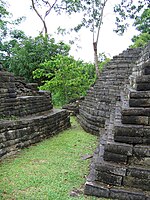 Lubaantun Belize Maya 730 to 890 CE Lubaantun includes many small step pyramids as well as the larger one.
Lubaantun Belize Maya 730 to 890 CE Lubaantun includes many small step pyramids as well as the larger one.
Nim Li Punit Belize Maya 400 to 800 CE Nim Li Punit has several small step pyramids.
 San Andrés, El Salvador the Bell of San Andrés Maya
600 to 900 CE This is a scale model of structure 5. There are
several other smaller structures that may be similar to pyramids on the
site.
San Andrés, El Salvador the Bell of San Andrés Maya
600 to 900 CE This is a scale model of structure 5. There are
several other smaller structures that may be similar to pyramids on the
site. AguatecaGuatemala Maya 760 to 830 CE This temple pyramid was left unfinished when the city was abandoned.
AguatecaGuatemala Maya 760 to 830 CE This temple pyramid was left unfinished when the city was abandoned.
Dos PilasGuatemalaLD-Maya after 629 CE This pyramid’s main stairway (known as Hieroglyphic Stairway 2) contains at least eighteen hieroglyphic steps.
Dos PilasGuatemalaEl DuendeMaya
after 629 CE This temple pyramid was built by enlarging and terracing
a natural hill some way from the site core, giving the impression of a
single massive structure.
KaminaljuyuGuatemala Maya
250 CE Kaminaljuyu contains some 200 platforms and pyramidal mounds
at least half of which were made before 250 CE. Some of these were used
to hold temples on top.
El MiradorGuatemalaLa DantaMaya
300 BCE to 100 CE La Danta pyramid temple has an estimated volume of
2,800,000 cubic meters which makes it one of the largest pyramids in the
world.
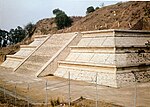 Cholula MexicoThe Great Pyramid of CholulaXelhua 300 BCE – 800 CE The largest pyramid and the largest manmade monument anywhere in the world.
Cholula MexicoThe Great Pyramid of CholulaXelhua 300 BCE – 800 CE The largest pyramid and the largest manmade monument anywhere in the world. Comalcalco MexicoTemple Maya
600 BCE to 900 CE The city’s buildings were made from fired-clay
bricks held together with mortar made from oyster shells. The use of
bricks at Comalcalco was unique among Maya sites, and many of them are
decorated with iconography and/or hieroglyphs.
Comalcalco MexicoTemple Maya
600 BCE to 900 CE The city’s buildings were made from fired-clay
bricks held together with mortar made from oyster shells. The use of
bricks at Comalcalco was unique among Maya sites, and many of them are
decorated with iconography and/or hieroglyphs.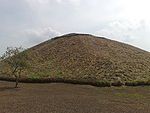 La Venta MexicoThe Great Pyramid Olmec
This is one of the earliest pyramids known in Mesoamerica. It was
made out of an estimated 100,000 cubic meters of earth fill.
La Venta MexicoThe Great Pyramid Olmec
This is one of the earliest pyramids known in Mesoamerica. It was
made out of an estimated 100,000 cubic meters of earth fill.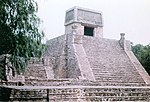 Santa Cecilia Acatitlan Mexico Aztec
In 1962, the architect and archaeologist Eduardo Pareyon Moreno
reconstructed and reinforced the pyramid’s basement and rebuilt the
temple that crowns it.
Santa Cecilia Acatitlan Mexico Aztec
In 1962, the architect and archaeologist Eduardo Pareyon Moreno
reconstructed and reinforced the pyramid’s basement and rebuilt the
temple that crowns it. Tenayuca Mexico Aztec
This is the earliest example yet found of the typical Aztec double
pyramid, which consists of joined pyramidal bases supporting two
temples.
Tenayuca Mexico Aztec
This is the earliest example yet found of the typical Aztec double
pyramid, which consists of joined pyramidal bases supporting two
temples. Tenochtitlan MexicoTemplo MayorAztec 1390 to 1500 CE Tenochtitlan was destroyed by the Spanish. Recreations of this and other pyramids are based on historical text and archaeological ruins.
Tenochtitlan MexicoTemplo MayorAztec 1390 to 1500 CE Tenochtitlan was destroyed by the Spanish. Recreations of this and other pyramids are based on historical text and archaeological ruins.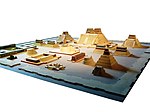 Tenochtitlan Mexico Aztec 1325 to 1521 CE Tenochtitlan
was destroyed by the Spanish. Recreations the city are based on
historical text and archaeological ruins. This site once included at
least half a dozen pyramids.
Tenochtitlan Mexico Aztec 1325 to 1521 CE Tenochtitlan
was destroyed by the Spanish. Recreations the city are based on
historical text and archaeological ruins. This site once included at
least half a dozen pyramids. Teotihuacan MexicoPyramid of the SunTeotihuacano 2 A.D. There are also dozens of platforms 4 stories high lining the Avenue of the Dead at Teotihuacan. These each step in each story and they have a stair way to the top in front of the platforms.
Teotihuacan MexicoPyramid of the SunTeotihuacano 2 A.D. There are also dozens of platforms 4 stories high lining the Avenue of the Dead at Teotihuacan. These each step in each story and they have a stair way to the top in front of the platforms.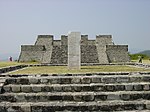 Xochicalco Mexico 200 BCE to 900 CE This is one of several other step-pyramid temples in addition to the Temple of the Feather Serpent
Xochicalco Mexico 200 BCE to 900 CE This is one of several other step-pyramid temples in addition to the Temple of the Feather Serpent
Xochitecatl MexicoThe Pyramid of Flowers the Preclassic Period
Xochitecatl
MexicoThe Spiral Building 700 BCE This is a circular stepped
pyramid. The interior of the structure consists of volcanic ash. The
building has no stairway giving access to the top, it was climbed by
following the spiral form of the building itself.
Source: http://en.wikipedia.org/wiki/List_of_Mesoamerican_pyramids
Egyptian
Giza
 Giza,
on the southern outskirts of Cairo is the location of the Pyramid of
Khufu (also known as the “Great Pyramid” and the “Pyramid of Cheops”),
the somewhat smaller Pyramid of Khafre (or Kephren), and the relatively
modest-sized Pyramid of Menkaure (or Mykerinus), along with a number of
smaller satellite edifices, known as “queens” pyramids, and the Sphinx.
The Giza necropolis has arguably been the world’s most popular tourist
destination since antiquity, and was popularized in Hellenistic times
when the Great Pyramid was listed by Antipater of Sidon as one of the
Seven Wonders of the World. Today it is the only one of the ancient
Wonders still in existence.
Giza,
on the southern outskirts of Cairo is the location of the Pyramid of
Khufu (also known as the “Great Pyramid” and the “Pyramid of Cheops”),
the somewhat smaller Pyramid of Khafre (or Kephren), and the relatively
modest-sized Pyramid of Menkaure (or Mykerinus), along with a number of
smaller satellite edifices, known as “queens” pyramids, and the Sphinx.
The Giza necropolis has arguably been the world’s most popular tourist
destination since antiquity, and was popularized in Hellenistic times
when the Great Pyramid was listed by Antipater of Sidon as one of the
Seven Wonders of the World. Today it is the only one of the ancient
Wonders still in existence.Sakkara
 Major
pyramids at Sakkara include the Step Pyramid of Djozer – the world’s
oldest monumental stone building – the Pyramid of Userkaf and the
Pyramid of Teti. Also at Sakkara is the Pyramid of Unas , which retains a
causeway that is amongst the best preserved in Egypt. This pyramid was
also the subject of one of antiquities’ earliest restoration attempts,
conducted under the auspices of one of the sons of Ramses II. Sakkara is
also the location of the incomplete step pyramid of Djozer’s successor
Sekhemkhet . Archaeologists believe that had this pyramid been completed
it would have been larger than Djozer’s.
Major
pyramids at Sakkara include the Step Pyramid of Djozer – the world’s
oldest monumental stone building – the Pyramid of Userkaf and the
Pyramid of Teti. Also at Sakkara is the Pyramid of Unas , which retains a
causeway that is amongst the best preserved in Egypt. This pyramid was
also the subject of one of antiquities’ earliest restoration attempts,
conducted under the auspices of one of the sons of Ramses II. Sakkara is
also the location of the incomplete step pyramid of Djozer’s successor
Sekhemkhet . Archaeologists believe that had this pyramid been completed
it would have been larger than Djozer’s.














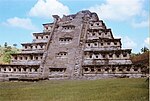
 Moral-Reforma MexicoConjunto
Moral-Reforma MexicoConjunto 


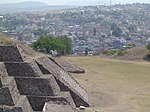
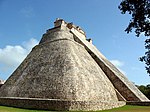
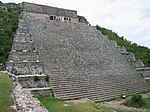
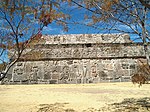

No comments:
Post a Comment